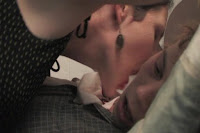Release Date: 2005
Contains spoilers
Oh dear. By rote I put the ‘contains spoilers’ warning whenever I do a review and yet sometimes there is nothing to spoil. Actually, in this case, that is untrue as there was very nearly a rather nice twist in this… very nearly, except that it was so badly handled, however I get ahead of myself.
This is a low budget independent effort and the DVD itself fills you with worry as it launches straight into the film – allegedly. What it actually launches into are three different trailers for this very film. These are not on a different menu track and you have to fast forward to get to the feature (or watch them of course). Kind of reminds you of the bad aspects of VHS days.
The basic story is that a couple of cops are called to a murder. A woman, Avia (Allison Valentino), joins them at the crime scene and flashes a badge. They ask to see it again and I am not surprised as it clearly looked home made. Supposedly it is a military ID. She is to assist on their investigation.
They head to a suspect's house and we notice that Avia is carrying a sword. Entering the house (without a warrant, mind) they end up in the attic and find the house owner with a sword also. Suddenly a vampire stands up. One cop is injured and the second is in peril and, with some of the worst choreographed sword moves, Avia takes the vampire out.
One cop ends up vanishing from the film for some time, to the point that I thought they’d forgotten he existed, and the other, Raymond Guy (Rodney Jackson), ends up with Avia – having found out that she isn’t military after all – and they have the most unconvincing, fully clothed sex scene every committed to film.
Let us stop there for a moment and consider the dialogue and acting. The acting has to be some of the most badly emoted I have had the misfortune to see and the dialogue has no basis in reality, things are said because the film needs to go in a certain way without consideration of why the character would actually say what they do.
Anyhoo, the film then has brief moments of Avia and Raymond and other moments of Avia either training, dreaming or searching for vampires. This consists of long, dreary scenes of Avia wandering around seemingly aimlessly and us wondering how a movie could be so badly paced. Lore is offered. Vampires came to be sometime in the 1800s – don’t ask me when, but I’ll get to the awful dialogue volume issues later – some seem human (though most of the ones we see are monstrous) and they are allergic to pine resin!
The effects in the film are varied from rubbish to surprisingly well done. The blind vampires are quite cool, though what the deal was with their tree branch fingers was beyond my ken and they lost kudos for that, and the vampire with the half rotten face looks good until the actor actually moves and then he looks as though he is caught in a very bad disco dance in slow motion.
Then again you also have skulls, either human or vampiric, that are so fake looking it is untrue and a vampire with a set of finger knives that look like tin foil wrapped around cardboard. It is really that bad. Oh hum.
Suddenly the film throws in a twist and, you know what, the actual twist itself is brilliant. Had the rest of the film been up to it I’d have been waxing lyrical about it but… It is so badly handled. Firstly it does not fit in with the film up to that point, assuming we have seen things from certain characters' points of view, and secondly because it is never consolidated. At the end we are not sure whether the twist was true or false – a mystery that was not satisfying in its vagueness.
The soundtrack is superb musically, though it often failed to adequately match the events on screen, and it is little surprise that the film seemed to have more credits for music at the head of the feature than any other type of credit but… We are playing volume roulette. The dialogue is so quiet compared to the music that you keep having to turn it up and down so that you can catch dialogue and then not deafen the rest of the household when the music kicks in.
For the attempt at the twist – and the fact that it was potentially brilliant – I am giving this 1 out of 10. The music helps the film scrape this point, as the action, dialogue, pacing and acting really should have pushed this to a big, fat zero. That said; it is nice to know that, as a vampire hunter, you can walk out of a suburban house, carrying a sword, raise a hand and be sure that a taxi will magically appear – batmobile eat your heart out.
The imdb page is here.


































































